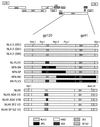Sensitivity of human immunodeficiency virus type 1 to fusion inhibitors targeted to the gp41 first heptad repeat involves distinct regions of gp41 and is consistently modulated by gp120 interactions with the coreceptor
- PMID: 11507206
- PMCID: PMC115106
- DOI: 10.1128/jvi.75.18.8605-8614.2001
Sensitivity of human immunodeficiency virus type 1 to fusion inhibitors targeted to the gp41 first heptad repeat involves distinct regions of gp41 and is consistently modulated by gp120 interactions with the coreceptor
Abstract
T-20 is a synthetic peptide that corresponds to 36 amino acids within the C-terminal heptad repeat region (HR2) of human immunodeficiency virus type 1 (HIV-1) gp41. T-20 has been shown to potently inhibit viral replication of HIV-1 both in vitro and in vivo and is currently being evaluated in a Phase III clinical trial. T-649 is an inhibitory peptide that also corresponds to 36 amino acids within HR2. This sequence overlaps the T-20 sequence but is shifted 10 residues toward the N terminus of gp41. Both inhibitors are thought to exert their antiviral activity by interfering with the conformational changes that occur within gp41 to promote membrane fusion following gp120 interactions with CD4 and coreceptor molecules. We have shown previously that coreceptor specificity defined by the V3 loop of gp120 modulates sensitivity to T-20 and that a critical region within the N-terminal heptad repeat (HR1) of gp41 is the major determinant of sensitivity (C. A. Derdeyn et al., J. Virol. 74:8358-8367, 2000). This report shows that (i) regions within gp41 distinct from those associated with T-20 sensitivity govern the baseline sensitivity to T-649 and (ii) T-649 sensitivity of chimeric viruses that contain sequences derived from CXCR4- and CCR5-specific envelopes is also modulated by coreceptor specificity. Moreover, the pattern of sensitivity of CCR5-specific chimeras with only minor differences in their V3 loop was consistent for both inhibitors, suggesting that the individual affinity for coreceptor may influence accessibility of these inhibitors to their target sequence. Finally, an analysis of the sensitivity of 55 primary, inhibitor-naive HIV-1 isolates found that higher concentrations of T-20 (P < 0.001) and T-649 (P = 0.016) were required to inhibit CCR5-specific viruses compared to viruses that utilize CXCR4. The results presented here implicate gp120-coreceptor interactions in driving the complex conformational changes that occur in gp41 to promote fusion and entry and suggest that sensitivity to different HR1-directed fusion inhibitors is governed by distinct regions of gp41 but is consistently modulated by coreceptor specificity.
Figures






References
-
- Berger E A, Murphy P M, Farber J M. Chemokine receptors as HIV-1 coreceptors: roles in viral entry, tropism, and disease. Annu Rev Immunol. 1999;17:657–700. - PubMed
-
- Blanpain C, Migeotte I, Lee B, Vakili J, Doranz B J, Govaerts C, Vassart G, Doms R W, Parmentier M. CCR5 binds multiple CC-chemokines: MCP-3 acts as a natural antagonist. Blood. 1999;94:1899–1905. - PubMed
-
- Chan D C, Fass D, Berger J M, Kim P S. Core structure of gp41 from the HIV envelope glycoprotein. Cell. 1997;89:263–273. - PubMed
-
- Chan D C, Kim P S. HIV entry and its inhibition. Cell. 1998;93:681–684. - PubMed
Publication types
MeSH terms
Substances
Grants and funding
LinkOut - more resources
Full Text Sources
Other Literature Sources
Medical
Research Materials

